I must be doing it wrong.
As a well-documented thrifty, nifty, and sometimes creative gal, I’m the first to humbly admit I can’t do it — I can’t raise my kid on a budget of $3,000 a year. That’s $250 a month, people.
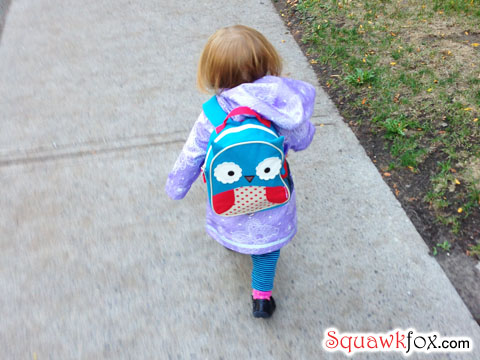
Walk like you own it.
A recent report by The Fraser Institute graciously outlines my failings as a so-called fiscally responsible parent, saying it’s never been easier “financially” to raise a kid in Canada, especially if parents only foot the bill for the necessities, such as: food, clothing, personal care, household supplies, recreation, and school supplies.
Really?
After reading the 65-page report a third time (mostly in disbelief), I nearly cried (like a baby) when the author Christopher A. Sarlo (an economics professor) said his $3,000 to $4,500 yearly range for raising a healthy child to age 18 could be cut further since he excluded “savings strategies such as home gardens, sewing and knitting clothing, couponing and taking advantage of sales, own repair and maintenance work in the home, etc.” in the total child-rearing tally.
Are you kidding me?
Many child cost studies cite the annual expense per kid in the $10,000 to $15,000 range. The Fraser Institute’s tally is a spectacularly thrifty bargain in comparison. I’m into it.

So perhaps with only 20 months of parental experience eroding my bank account I shouldn’t be so quick to throw in the spit-up covered towel. Maybe it does cost just $3,000 to $4,500 a year to raise a healthy baby, toddler, pre-teen, or teenager to age 18? Teens don’t need iPhones, right?
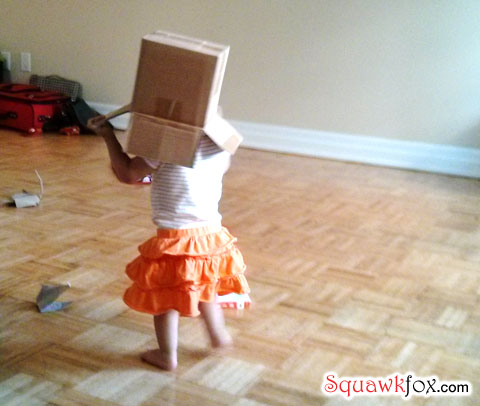
She’s not getting an iPhone. The cardboard box will have to do.
So rather than launch a toddler-sized tantrum over Mr. Sarlo’s child-rearing numbers, I’ll raise this gobsmacking report one frugal cloth diaper and show you guys where The Fraser Institute says I’m overspending lavishly on my kid.
Maybe you’re overspending too. Cough.
Daycare costs or lost wages. Pick one.
I spend nearly $20,000 a year on daycare, after tax. Not working costs me more. When Carl took parental leave, the opportunity loss in unearned wages was expensive too. That’s the price many parents pay after bringing baby home — you either cut a fat cheque for daycare or you lose a fat paycheque to have a parent stay at home. The math is painfully simple.
But parents in The Fraser Institute’s family don’t have to bother with daycare’s inconvenient and costly expense. That’s because the institute’s report writer and fancy economic professor decided, rather conveniently, not to include the costly cost of daycare in the annual cost of raising a child. Mr. Sarlo writes:
“The exclusion of daycare costs from the list of needs using the budget standard approach is not because daycare is not a legitimate expense for households with children but mainly because many families with children will have little or no daycare costs.” — Christopher A. Sarlo, The Fraser Institute
This is awesome, mostly because everyone knows spending $1,517 a month on daycare handily blows through the entire $3,000 annual child raising budget in less than two months. I’m also wondering why many licensed daycares boast year-long wait lists when so many families have “little or no daycare costs.” Head scratcher.
Conveniently, the report also fails to account for silly lost wages. Unless the majority of Canadians have access to free childcare and both parents are still working, the cost of raising children should account for either daycare costs or income losses.
Bottom Line: I’ve blown 51% of my $3,000 annual child raising budget in just one month, thanks to a monthly $1,517 daycare bill.
Housing ain’t free.
The Fraser Institute doesn’t think growing families need more space, so they excluded the cost of shelter from their cost of raising kids tally.
“Indeed, not only is it inappropriate to count housing as a cost of children but, based on available expenditure data, an additional child will often not increase housing costs, independent of changes in disposable income/consumption.” — Christopher A. Sarlo, The Fraser Institute
As a rural British Columbia homeowner who now rents an apartment in Toronto, I have some diverse experience with providing shelter for a child.
When baby Chloe came home to our two-bedroom house in rural B.C. we didn’t require more space, but we did need to reallocate the space we had. Let me introduce you to my former home office — the pretty space where I worked, studied, and freelanced my arse off to pay for living expenses.

My home office before baby.
Today my home office is a lot less office-y. Welcome to Chloe’s bedroom.

My home office after baby is more of a nursery.
So where’s the cost? Chloe needed a crib and other furniture, I needed a new space to work. The cost was moving my business into the basement and buying shelving to deal with the cascading effect of relocating the stuff in the basement. Kids often force you to rearrange your current housing arrangements, even if the cost isn’t upgrading to a larger house. New parents should budget some bucks to home reorganization as a child-related expense.
But not everyone who starts a family lives in a two-bedroom home with an office that can be converted into a kid’s crib. Since moving to Toronto, I’ve lived the nightmare of living in a one-bedroom apartment as a three-person family. We tried to make it work. We failed. Miserably. When a two-bedroom place became available in our building we took it with the added cost.
Couples living in small studios or one-bedroom spaces should face reality and budget for a larger apartment. Kids have stuff (clothing, diapers, toys, cribs or beds) and need space where they can nap and sleep — a room with a door that closes is preferable for parental sanity.
I can’t imagine how Fraser Institute families live and sleep. Do all the teenagers share bunk beds in the master bedroom with mom and dad? ‘Cause that would be awesome.
Bottom Line: The price difference between a one-bedroom and two-bedroom apartment in our high-rise building in Toronto is $604 per month, or $7,248 per year. That’s a real shelter cost for having a kid.
Smart Cars are not for kids.
Transporting kids is practically free in the world where the Fraser Institute travels. Any vehicle change thanks to kids, writes Mr. Sarlo, should be “attributed to parents (and their new lifestyle) and would not be a cost of a child per se.”
Our transportation “lifestyle” before Chloe was humble. As the perfect DINK couple (dual income no kid), we owned a vehicle that suited our simple two-person needs.
Enter the Smart Car.
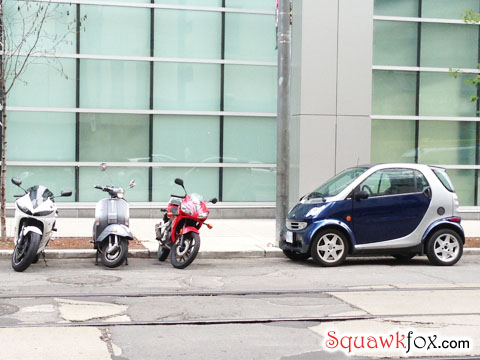
The perfect urban assault vehicle for moving herds of children around town in spacious style. If you have a kid and own a Smart Fortwo, good luck strapping your spouse or yourself to the roof for a casual trip to Costco. When the peops motoring along the highway in Hummers honk, just wave casually (using the one finger salute) like nothing is wrong.
But something is wrong. The Ministry of Transportation won’t let you travel with babies who legally have to be in rear facing car seats in vehicles like a Smart Fortwo. The issue is airbags and this thing called safety. Also, I still need a third seat for this thing called a husband.
Now let’s not forget about car seats, OK? There are infant car seats (for babies), convertible car seats (for toddlers), and booster car seats (for whatever happens after toddlers stop being toddlers). Expect to spend from $50 to $200 (or more) to take a ride in any of these legally required bummy boosters. How did the Fraser Institute miss car seats? Anyways…
Moving to Toronto I thought I avoided additional transportation expenses because the ‘House of Squawk’ would take the subway, so no need for costly car seats and bigger cars. I was mostly wrong. While we do travel exclusively by train, the problem was less about car size and more about stroller girth.

Enter the BOB Revolution Single Stroller — the perfect urban assault vehicle for plowing your kid over unpaved rural roads and rusted cattle guards. Our used BOB stroller was a frugal spend and the perfect blend for our lifestyle in British Columbia, but Toronto living and subway travelling requires a smaller, lighter ride.
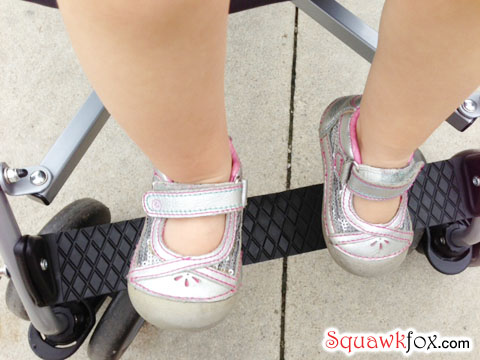
Compact and cartable umbrella strollers are the thing for city dwellers, mostly for fitting on trains but also for carrying down the steep stairs in stations. Lugging the BOB with a child down these inclines is dangerous and impossibly heavy for me. Many subways stations in Toronto are not wheelchair accessible, so parents cart and carry their strollers down the stairs.
Bottom Line: While I escaped spending the big bucks on car seats and a bigger automobile, I still needed a second stroller for transporting my kid around town. Parents would be wise to include a few transportation costs in their total for raising a kid. Two used strollers plus one new car seat total $650. Roll with it.
Formula is food for some, sorry.
I guess the Fraser Institute lives in a perfect place where milk and honey flow freely and every baby saves their parents money by being breast fed. Only “basic marginal costs” are accounted for in this study after all, and “the cost of children does not include special needs costs as the vast majority of children are not in this situation.”
While breast feeding is many parents’ preferred method of nurturing a child, it is not always possible.
Enter the “special need” cost of baby formula.
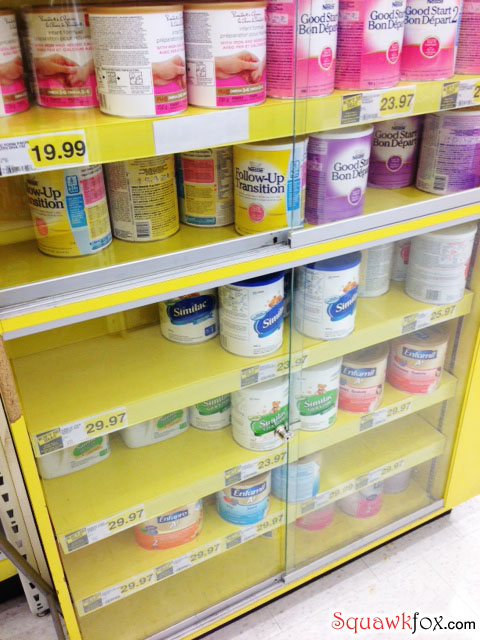
Baby formula is so expensive, and presumably theft-worthy, that our local discount grocer No Frills locks the stuff up. The Shoppers Drug Mart around the corner won’t even let you touch the canned powdery fortified milk — shelf-sized popup displays show you how the formula looks, but you’ll need to buy it at the pharmacy to get the goods home.
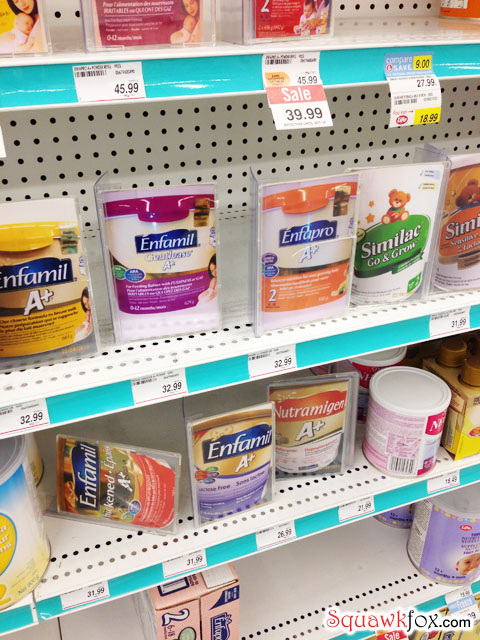
Shoppers Drug Mart sells baby formula over the counter to presumably prevent theft.
No wonder retailers treat baby formula like liquid gold. At $32.99 for a 629g (22oz) tin you better hope your baby doesn’t spit the costly stuff up. Riiiight.
Sure, I’d shop sales and use coupons, but the cost to feed a formula-fed baby ain’t cheap. Costco offers some financial relief for families in need of formula, so I’d stock up on Kirkland brand super-sized formula tins every trip. Spending $150 per month on baby formula was our new normal.
Bottom Line: Even with sales and coupons, don’t discount the cost to feed kids of all ages and sizes with “special needs.” Our total formula tab is around $1,800 for our prematurely born daughter.
Knot knitting a pair of jeans, thanks.
Mr. Sarlo says the “sewing and knitting of clothing” would help “reduce the money cost of a child.” Has Mr. Sarlo checked out the cost of fabric, patterns, and other notions lately?

This denim sale at Fabricland looks promising. For just $6-$12 per meter (regular priced at $26 per meter) I can buy a bit of fabric to sew my kid a pair of pants. I’ll need a plan though, so this $12 girl’s jeans pattern on Etsy looks perfect. Add in the cost of buttons, a zippered fly, and thread and I’m easily over $20 for a pair of toddler pants. Hope you own a sewing machine. Perfect.
After working full time, house cleaning, home cooking, laundry washing, child caring, and sleep deprivation depriving I’m totally into the idea of sewing my kid a pair of pants.
Shopping secondhand at thrift stores like Value Village can be far cheaper anyways. These Oshkosh overalls cost $2.99 used, that’s over $10 cheaper than sewing my own the Fraser Institute way.
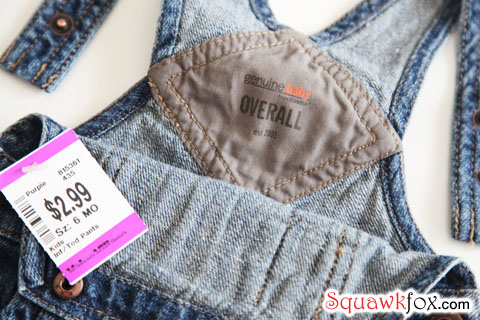
Mending is a must, so I’m not opposed to a bit of handy work.
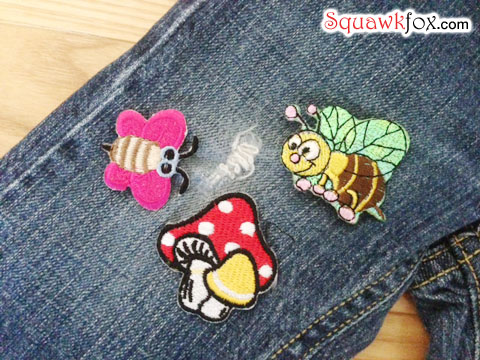
I save a bundle by buying already made second-hand clothing. This stash of kiddlet gear cost around $36.
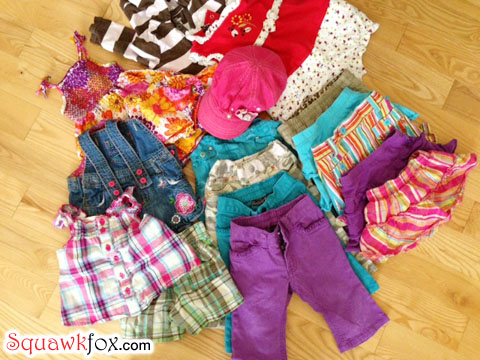
Bottom Line: Unless you love to sew and can find frugal fabric often, it’s tough to source notions for less than the cost of second-hand items.
$hit my kid destroyed.
Distraction before destruction — that’s my motto these days. With a 20-month-old toddler tantrumming around my home I need to make quick, cost-saving decisions on what I’ll let the kid destroy so I can get dinner done.
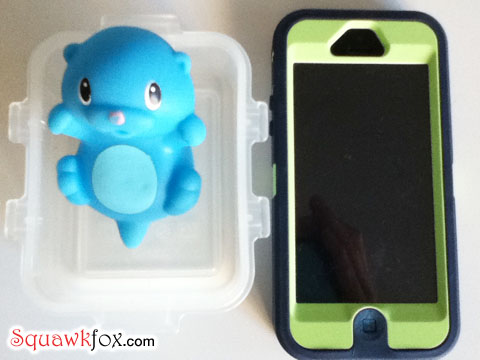
My kid shows me how to build a frugal OtterBox.
Behold my $783 unlocked iPhone. Good thing I spent the bucks on my OtterBox Defender Case because my kid is hellbent on dropping and destroying this device. Her recent trip to the “potty” to teach my iPhone to “swim” had me investigating waterproof iPhone cases in an effort to not sink the cost of my lovely smartphone.
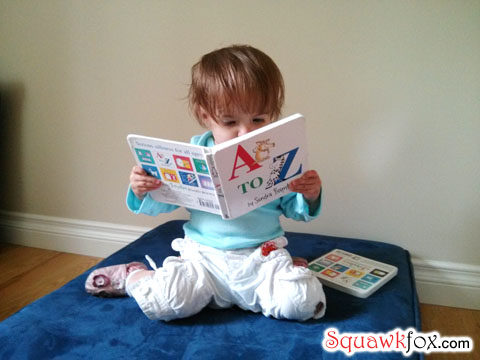
Kids will really destroy anything though. Books, clothing, furniture, big appliances, small appliances, floors, walls, toys, or whatever they can get their grabby little hands on. The book Sh*t My Kids Ruined: An A-Z Celebration of Kid-Destruction shares the costly damage with painful photo evidence.
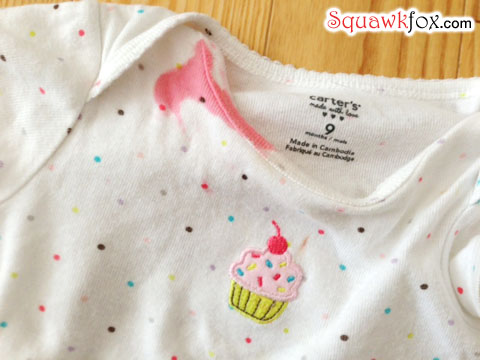
This stain just gives her onesie “character” right?
Teenagers destroy stuff too. Try teaching a teenage gal how to reverse-park a standard car in a garage situated on a serious slope. She may (or may not) rip the driver side mirror straight off the driver side door. This may be a true story. Or not. I digress.
Bottom Line: I don’t know how to calculate the cost of kids destroying stuff, but brace yourself for the expense ’cause smartphones will sink or swim.
The price of Pampers.
It’s a good thing I did a price check and calculated the real cost of diapers because I think the Fraser Institute could use the lesson. I would also like to neatly ignore the expense of diapering a child by calling it “clothing,” because like ‘The Institute’ I hate dealing with diapers too.
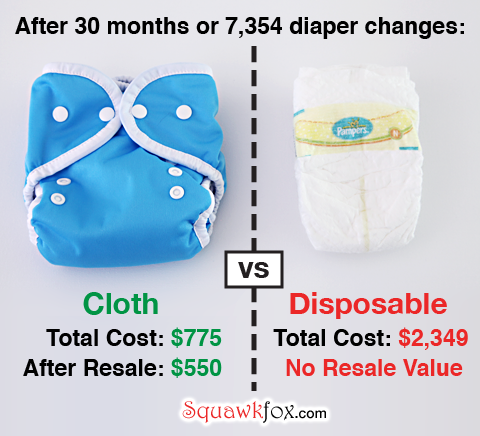
In my very popular post Are cloth diapers worth it? I calculated the nappy numbers and found that over 30 months, disposal diapers cost $2,349 and cloth diapers run a less expensive $775.
Containing bodily fluids is expensive. Glossing over the gross doesn’t make the cost go away. Parents should account for the price of disposables or reusable cloth diapers in their budgets for raising kids. Budget blowouts may result as a costly consequence.
Bottom Line: Disposable diapers can cost around $940 per year while a laundered cloth diaper stash is more hands-on and less expensive at $310 a year.
So where am I going with this?
Raising kids costs some amount of money.
The Fraser Institute cites $3,000 to $4,500 a year — or $81,000 total to raise a kid to 18. This nifty figure excludes the costs of child care, housing, transportation, “special needs,” and even diapers. Hope your kid doesn’t need braces. Anyways.
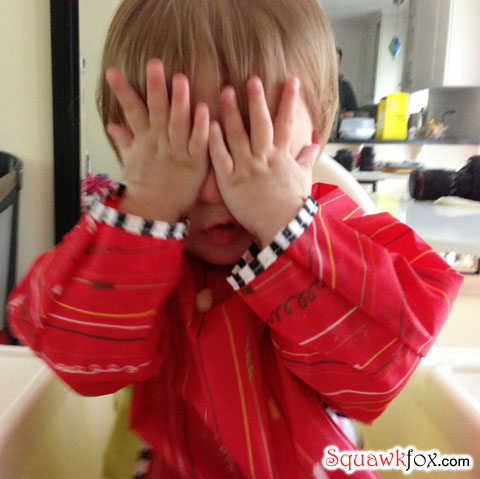
“Don’t show me the math.”
Adding up ‘The Institute’s’ omitted costs I’m easily over their $4,500 dream world number.
Daycare: $18,200 per year
Shelter: $7,248 per year
Transportation: $650 first year
Formula: $1,800 first yearCrybaby Total: $27,898
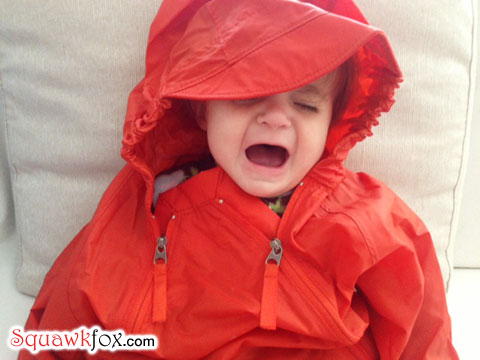
“I’m expensive!”
So where did I go terribly wrong?
In 2011 MoneySense tallied the total raising kid cost closer to $243,660, or $12,825 per child a year until 18. Read “The real cost of raising kids” for the essential details.
In “Million-dollar babies”, Maclean’s pushes the total even higher by including “lost income, forgone investment savings and the price of a college education.” Their child raising tab is close to a million bucks for two bundles and $670,000 for a single child.
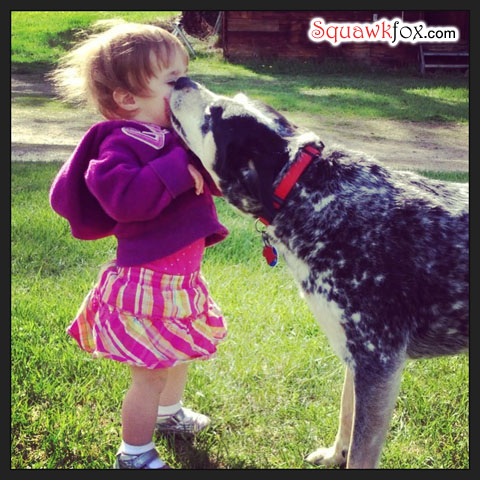
Lots to love, even at that price.
So what does it cost to raise a child?
I’d say anywhere from $3,000 per year to a million bucks over 18 years. Yeah, have fun paying for that.
Love,
Kerry
Your Turn: Can you raise a kid for $3,000 a year? I’d love to hear from more experienced parents with older kids since my math is limited to just 20 months of child raising experience.
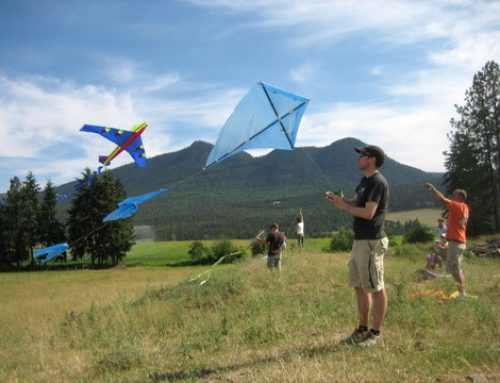
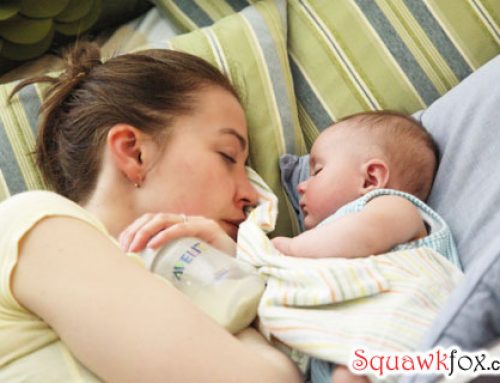
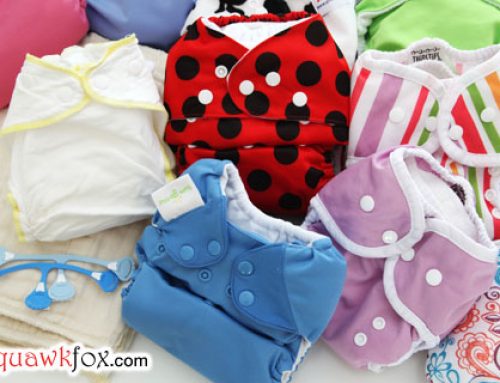

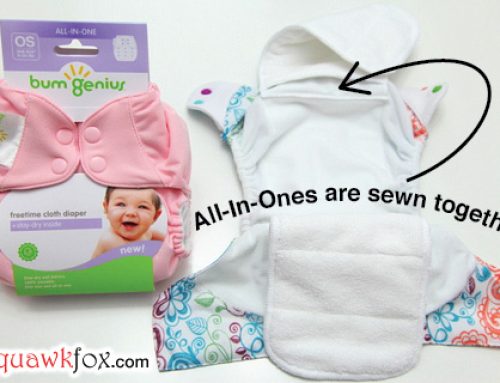
I have always believed that the folks at the Fraser Institute don’t live in the real world. Now I’m sure.
You haven’t even touched extra medical expenses, and let’s just not talk about what happens when a boy reaches the teenaged years. Formula costs? A drop in the bucket compared to what a growing boy will cost you!
Then, of course, there’s extra education costs. I didn’t put my kids in hockey because I wasn’t willing to drive them to practices on Sunday mornings (which is when many leagues for kids have ice time), so we chose music lessons. While I don’t think it’s necessary for kids to be out every night of the week, I do believe that they need something more than video games and school in order to grow up to be well rounded young people.
And a warning to all parents who look at these numbers and gasp: very, very few kids are independent of their parents by age 18, which is where both of these numbers stop. As a mother of three twenty-somethings, I got news for you. It doesn’t stop until they’re working full time at a steady job and out of the house, and of all the kids in that age group I know (and I know quite a large number of them) the only ones who were totally independant at age 18 and not costing their parents money (total sample 2 out of a few dozen or so) did not go on to post secondary education, are earning the minimum wage, and have very little hope of earning very much more.
And finally, as I found out some months after my youngest son’s second birthday, some children are yours for life. A child with a disability means never-ending lost wages or daycare costs, or in most cases both, and you can not really predict that cost. My son is 23, and until his father retires, someone has to drive him everywhere he has to go, prepare every meal he eats, stay at home with him when he’s sick, and even do a certain amount of personal care for him, and that someone is me.
Lost wages? The career that I’ve had to give up would see me earning about $65,000 per year or more if I’d been able to go back to work full time, and now I get $1200 per month in spousal support and about $250 from delivering the newspaper. That blows even the Moneysense estimate out of the water in just five years!
Don’t get me wrong–I’d do it again in a heartbeat. Even down to the autistic youngest. But raising a kid is more expensive than most folks realize, and it’s best if prospective parents know this before they ditch the condoms or fill out the agency adoption forms. 🙂
I can certainly try…
So here’s our cost breakdown for our kidlet: Preparations for the kidlet, 1500 euros (including bed sheets, clothes, furniture, painting the room). Stuff we needed to get after he was born, like bigger clothes, the mei tai, beanbag chair, and a couple of other things, was probably around 500 euros. I don’t really factor in his food, since he was breastfed, and now he eats what we eat. And we don’t have child care costs–while I do work from home, most of that happens in the evening, from 8 until midnight, after the kid is asleep. (If hubby is home, then I can make him clean the kitchen and get an extra hour in 🙂 ). I don’t do cloth diapering–I thought I would, but the extra trash that it amounts to is a lot less than we were afraid it was going to be, and since he started sleeping through the night, he only goes through about 4-6 diapers a day, so a large pack lasts us about 2 weeks, cutting his diapering costs to less than 30 euros a month. It would be a lot more if I chose to use Pampers (they’re almost 3X more expensive than the generic store brands), but I could never understand the logic of getting such expensive diapers, since it’s recommended that you change diapers every 3-4 hours anyway.
But also…seriously, sewing your own clothes? I mean, I’m pretty handy with a sewing machine, but sewing is expensive if you care about quality fabrics and proper fastenings and the like. One of my friends is a knitter, and he spends anywhere from $50-100 on quality yarn (his sweaters and lace shawls, it must be said, are gorgeous).
Hey Kerry, over on my blog I wrote about this the weekend this farce of a report came out. I have several years of parenting experience on you, and let me tell you it does not get cheaper. Have you checked activity costs? I guess that is why they give a tax credit for that one, oh wait their are school costs and that is even if they are in public school, don’t forget the school fundraisers, how about an extra person to take on that rare vaction..they only travel free till 2, and don’t forget an allowance, and heck mine is now a teen, needs $100 in uncovered meds, high school fees in the door of $100, and her bus fare..hmm, yeah it just gets cheaper (NOT)..you are in for a ride my friend, and the Fraser report got it way wrong.
That institute is smoking some serious dope. I breastfed all 5 of my children. I shopped garage sales and found fabrics for really good prices and I sewed a lot of their clothes when they were younger. And I know it cost way more than $3000 a year to raise my children. And as teens they just get more expensive. They are bigger, therefore, their clothes are bigger and they eat more. Trying to keep a teenage boy from “starving to death” between meals is nigh unto impossible.
To exclude all those things that are a part of raising children from the cost of raising children is ludicrous. Where does he think the child(ren) live? In the street?
You are talking about raising a child the way you would like to raise one. And that costs money. And can cost a lot of money. wait until yo reach university years and the kid can’t work and study too effectively. But there are plenty of people who raise a child on less – just not to your standards. There are grandmothers babysitting the child, looking after them after school for no compensation. They also sew and knit a lot of the child’s clothes. What did people do before formula feeding was possible? When I was a child, mothers made their own “formula” for the bottle – there wasn’t anything to buy that was already made up in bottles or cans. Nothing. Just pablum. Baby food is expensive but using your own food is cheaper. Few mothers bought jarred baby food when I was young – some must have because it was on the store shelves, but I never saw it in anyone’s shopping cart. Babysitters? Nope – if the kids couldn’t go too wherever the parents went, the parents stayed home. Activities that cost money? Nope – playing catch on the grass lawn didn’t cost much other than the cost of a ball. Playing tag and hide and seek were even cheaper. There were no allowances, no treats during the week, no pop and juice was served at breakfast. Cloth diapers were handed down in the extended family as were clothes and cribs. The changing table was the kitchen table often or the parents’ bed. A playpen wasn’t allowed in our home and we survived. Strollers weren’t there either – we stayed in the buggy until we could walk by ourselves. There were no such thing as car seats in cars and there weren’t even seat belts. Speed limits were higher too. I’m not saying that things were better then but they were different. Oh – and driving a car? Forget it. That was Dad’s car and we drove when we earned our own paychecks and made our own decisions about how to spend our money. Until then, it was Dad’s and Mom’s roof and that was made known often. Living in a tiny 2 bedroom house for all my growing up years made me appreciate my own space like Virginia Woolf. I think that the Fraser Institute relies on the two sets of grandparents to raise the child financially today.
Hello, I have two children – a 2 and 4 year old. I nursed, made pureed first foods, cloth diapered, thrift shopped, had a bunch of showers which supplied us with many wonderful baby supplies. I am a stay at home mom, we save on daycare and the other expenses with having a career. I think when they start school things just pile up…couple with the fact they seem to turn into picky eaters therefore more food waste. In regards to the report, I think it’s off course, very idealized. If it is published to encourage families to produce children, it may succeed, however these families will be in shock once they find the realities of it all. Like you said, some parents need formula or use cloth diapers for their child(ren), and that is costly! Moreover those folks in marketing and peer pressure can really guilt parents into believing they really need something for their kid when in reality one doesn’t…but they buy it anyway. And if your child isn’t healthy, trips to the hospital…parking, food, babysitting of siblings, gas etc.
Something tells me that the Fraser dude has never had children of his own. I may not have children, but I sure know that it can cost more than just an arm and leg, and because most parents do not have the luxury of staying at home with their bundles of joy, daycare costs alone are phenomenal. You may be able to pull off the $3000 figure if your child is happy to exist on a carrot stick a day while wearing a burlap sack and sleeping in a manger…
As usual your blog had me laughing so hard I had tears in my eyes. I did not read the Fraser Institute report and I’m very glad I didn’t waste my time. I know I would have been furious!
My girls are 17 &19 and I can tell you that we have lived a very “no frills” life: breast fed both , 80% of their clothing was goodwill/garage sale/hand me down, strollers/car seats/cribs etc second hand or gifts, home made baby food, 4 of us in a 2 bedroom home etc etc. Part of the frugality was by choice, part because in the first year having both girls , I had a a laid off hubby with cancer and me being self employed w No benefits was really tough.
But I completely agree with you that a Bare Bones life definitely costs Way More than $3000per child per year.
Did The Fraser Institute not take into consideration that breast feeding mums Need extra food, that washing cloth diapers uses soap/water/hydro, that it costs money (gas/parking or bus fare) to take babies to the Required doctors visits, that school field trips cost money, are part of the curriculum and Not an option, school uniforms cannot be hand knit, that unless you’re feeding you child packaged/processed/plastic food, it’s expensive.
I guess the folks at the Fraser Institute heard that “It takes a village to raise a child” and assumed that the villagers would foot the bill!
I’d love to thank my child-free readers for sticking with my bloggy blog (and commenting too) while I explore the various costs of kids. Love love love, me.
All these letters have convinced me that I made the right decision at about age 16 that I would never become a mom. (Health issues later sealed that decision for me, so I never had the chance to be a biological mother.) I have many friends who struggle continuously even on 2 incomes with the costs of needs for their kids.
Did the Fraser Institute forget to mention that elementary schools no longer provide ANY basic school supplies for students, except textbooks? When I went to school my parents didn’t have to buy pencils, pens, erasers, rulers, or notebooks from kindergarten right through Grade 6. What are these kids supposed to do their work with now, chalk slates?
I too would be interested to know if the author of the report is a parent, and see their budget for their children for a year.
Ha ha ha ha!!
I have two kids. We bought our house in 2004 (ugh, well that was bad timing). It’s a 2BR, and we have two boys, so we haven’t had to “trade up” but it is getting tight. When they are both teenagers? Ugh.
But childcare? Yes. My childcare for the infant in home daycare is $13,000 a year and the after school care and summer camps for the big boy is $5000 a year.
I breastfed both boys but started on formula with #2 at 8.5 months, and that was a significant expense until age 1.
And I use disposable diapers, sorry.
I haven’t spent money on clothing – lots of friends passing down used clothing for the baby. The big boy – after age 4, you just cannot pass down pants.
My kids are 2 and 4 with another one on the way. I can say that it would definitely have been possible for us to meet that mark. It’s all about choices.
Daycare: For many people the decision to have both parents work outside the home is a choice. Of the people I know only one couple has had to do it to pay bills and not support a lifestyle. Single parents are often in a worse situation, but many people also have family or friends who watch their kids for cheap or free.
Housing: If you live in a one-bedroom apartment then you’ll probably want to get a bigger place, it isn’t a biological need but for sanity’s sake I will grant that it may be a mental one. Most people do not live like that. Most people could fit a child into their existing living space and not increase their housing costs.
Gear: Babies do not need cribs, swings, or many of the other “necessities” that make life easier. I know many people who have a toddler, twin, or other size mattress on the floor for their child to sleep on. It apparently works great for them. My crib mattress was a bare bones model that cost $30.
Cars: Where I live most people are not driving smart cars. They just don’t. Most already have some huge vehicle that can easily hold 2 – 3 kids in the back. We have a Prius and are just now, with our third child due in February, having to buy a bigger one, because I don’t want to have to fasten my 4-year-old into her seat in the middle of the car. I’m just not young and flexible enough to be willing to do that when I don’t have to. However, if we cannot find the money in our budget for a minivan that is exactly what we will do and I will be asking advice from the people I know who are already doing it.
Car Seats: I splurged to get a model that would last a long time. My 4-year-old is still in it and it cost <$300 on Amazon. I could have gone cheaper but we are tall people and I won't take a chance on safety, so I chose to go with the extra bells and whistles that would make it easier to use properly.
Strollers: I got my double stroller at a consignment sale for $50. My previous one was an infant seat/stroller combo for $200, I believe. I didn't bother pricing them because it was a gift that I would not have bothered with otherwise. My Ergo was $70 on sale and many moms I know don't use a stroller because they are rabid babywearers. I am not due to joint issues, but my problems are not the norm and my stroller wasn't that expensive anyhow.
Formula: Most mothers are capable of breastfeeding. The human race would not be here otherwise. There is no way that humans have lost the biological ability to breastfeed over the last 150 years. Often women are told they can't, but they can. Often women choose not to, but they can. For most formula comes down to choice. Breastfeeding isn't quite free since the mom does have to consume about 500 extra calories a day to make the milk, but I'm not doing the math to figure out what that would come to.
Food: I've never bought baby food so I don't really know what it would come to. With my first I made it, with my second I did baby-led weaning so he just got food from my plate. Neither of my kids cost very much in food yet, that will naturally change as they age. My husband and I are both big eaters so I expect this to be one of our two big expenses in the future. (The other being clothes as we are both over 6' tall and will likely have hard-to-fit kids as well.)
Clothing: Many people get hand-me-downs and have almost their entire wardrobe for kids free. I am not one of those. I also could not sew or knit one. What I can do is shop the consignment sale. I get almost all my kids stuff at our local, semi-yearly consignment event where I spend about $300 a time. Most of that is non-essential as my kids have way too many clothes and toys. I just cannot pass up wooden trains and Legos. But my kids don't need most of what I buy there and this year I will not be spending nearly that amount.
Diapers: Cloth diapers are a possibility for most people. It may not be a choice they want to make, but they can. I personally would need to be dead broke before considering cloth diapers without my washing machine, but I do know a family in that situation that makes it work. I will accept your price estimate on those, I haven't done the math yet.
Lessons: These just aren't necessary. They may be desired, but if we are talking luxuries, which these are, we could get the cost to raise a child very high, indeed. I won't factor them in because they aren't required to raise a child and they aren't even required to raise a child well. They are an option for families with the money to pay for them.
Medical: I can't really comment here since I am in America where our health care landscape is changing. In past years I know uninsured people who have paid very little for their health care for their kids. We paid more since we carried insurance on them, but my 2-year-old hasn't seen a doctor since he was a few months old and that was for a specific problem with his arms that most children don't have.
Bottom line: Yes, $3000/year is doable to raise a child if you had to make it work and had no extra expenses. Most people just aren't willing to make the choices to do that, myself included.
Sssshhhh! Calm down everyone. OK? ok…
I am not going to spend time discussing most of the pitthy young things being discussed. Put $250 in a savings account each month so that when the time comes, you can pay for his/her college and medical school.
In the tiny time you have, 0-5 years before things happen that are out of your control, Love them and TRUST them. And never say anything that teenagers might say ; it will come right back at you many years later.That is my #1 life expeirence rule:
You must be able to say ” I have never spoken to you that way AND you will not speak to me that way”.
It takes you 1- 20 years to master this. But it sure builds trust.
Wow– I have 4 amazing kids 2 of whom are autistic and I blow that budget on traveling to therapy and medical appointments alone. Not to mention the career that I gave up to stay home to raise my kids (which I did so lovingly and am glad for the time home with them— but that pay check sure is missed sometimes) I’d like to see the institute come to my house and show me how to raise my kids on this little amount I consider our house fairly thrifty but hey won’t turn down the help if they could actually come into a “real” home and prove their budget works.
I don’t have children (yet!) but even I know that $250 per month doesn’t do a heck of a lot for raising a child. I love how easily items are discarded from the total in that report. Absurd.
“Bottom line: Yes, $3000/year is doable to raise a child if you had to make it work and had no extra expenses. Most people just aren’t willing to make the choices to do that, myself included.”
Bingo! You guys need to realize what this study is. It’s not a real world example, put out to chastise people for pampering their kids. It’s an analysis showing how cheap a generic family _could_ make it if push comes to shove. From the summary of the report (which i insert after having written this entire post, and find that some of my post is addressed in the summary of the report. I’m too lazy to edit out those parts of my post):
“The objective of this paper
is to find, at least, a base level of annual child costs that would need to be
covered for the healthy development of the child.
The cost of raising a child is defined as the cash outlay “marginal” costs
that parents spend when they add a child to their household. These costs specifically exclude any costs that were already in place prior to the child and
would still be in place if the child leaves the household. The cost of raising a child is usefully distinguished from the costs involved in the decision to “have” a child, which necessarily includes the full opportunity cost of such a decision.”
Some of the analysis in this article strikes me a little strange.
It seems strange to include opportunity costs in the costs of childcare. Yes, they factor into your decision to work or not, but they aren’t a cost of childcare, you don’t have to pay an “opportunity cost” bill each month. You have a choice. Do you incur more childcare costs in order to get more income, or do you incur less childcare costs?
It also seems strange to include costs unique to your situation, such as costs of changing your transportation and housing. Remember, they’re looking at bare bones, which would seem smart to not take into account non-preventative medical care, costs due to specific housing and transportation issues, broken things, and special needs costs.
I see the study as a good baseline… It costs $3000/year to keep the kid alive until age 18. From there, I can allocate additional money to give the child more than just “3 hots and a cot.”
People seem to forget to add the cost of water, detergent and hydro to wash clothe diapers they seem to only factor in the purchase cost
Ah the good old days of arguing about the cost of parenting, and I can assure you it ain’t that $3K a year, unless you are living on a farm, and allowing your little ones to wander around and poop wherever you like.
Another thing to add is you haven’t even started saving for your darling child’s future. If you put $2500 a year into an RESP (per child too), by the time your little one gets to University you’ll have enough money to pay for 3 years of tuition (and that is about it).
Parenting costs what it costs, if you were worried about budgeting and making sure you could still afford your BMW, why did you have kids? The money gets spent, sorry, but the Love more than compensates for it (Dad of 3 amazing daughters all in their 20’s and an 8 year old).
I agree that the study seems to rely heavily on the premise that only the absolute basic needs of the child are met.
However, even with that premise not including child care, or the opportunity cost of self provided care, is a huge oversight for an economist!
Even when relying on family/friends for the child care, they themselves also would have opportunity costs not covered in the study.
Having said that, it is clear to me that a substantial amount of money I spend on my children is discretionary. My kids do not absolutely require RESPs, after-school activities, “treat” foods/toys, etc. and if I was forced to I would do my best to raise them without those first-world luxuries.
Its possible because somehow my parents raised 6 kids on one minimum wage income. When you don’t have the money your kind of forced to adapt. We never had the best or nicest things, family vacations meant road trips and crashing with extended family, but it worked. 1 of my siblings is now perusing her masters, 3 of us are in undergrad, and the little 2 are in elementary school.
I spend more than $3k per year on my dog!
Several families I know have covered child care without giving up a second income by working shifts. The cost on a marriage of the parents working alternate shift hours, though, can be very high. It’s also not possible for someone working the true night shift to provide child care during the entire day because they have to sleep sometime. Sleep often ends up shortchanged and that can lead to some nasty health complications down the road.
Did they budget for eyeglasses for each child? Even at $99 that can add up quickly. What about dental care? Was there anything included for the $100 (each) checkup and the occasional $200 cavity?
Overall I’d say flip the report into the recycle and move on.
The cost of RESP and university is NOT part of the cost of raising a child, so don’t stir that pot.
That is a choice by parents, but not part of the basics of life, nor part of getting a kid to age 18.
While 3K is not a lot of money, I believe most parents WAY overspend on their little darlings.
No, teens do not need a cell phone. Nor do they need every video game, sports club, theatre, etc.. They might want it, and it might keep them out of your hair, but those are NOT necessities of life.
Getting a child to age 18???? And that’s it??
I beg to differ. Even without “extras”, the High School Graduation into marrige is way passe!! You are shucking your responsibilities.
I think the fine folks at the Fraiser Institute are using all the money they saved on raising kids and using it to buy and smoke crack. I think that’s the only way they could legitimately come up with those numbers!
I have raised two sets of kids the older ones being 32,30,28; the younger a set of 15 year old twins at this time. I was a teen mother who was married young. Others were extremely nice to me and had huge baby showers for me. Family purchased the crib,pram and high chair (used). I breast fed all my children until 8 mons and weined them onto homo milk (not acceptable now) I did use cloth diapers at home and paper ones when out. I stayed home and babysat others little ones for extra money until my third child was three. Our family vehicle broke down and my husband was already working two jobs (low paying) I had a chance for free daycare for one year. I took it so we could afford a used mini van. We probably spent less than 3000 a year sometimes but we constantly had to do things like grow gardens,can food, make everything from scratch, help on a friends farm(he could not afford a labourer) in exchange for beef and pork sides. I one time bought year old laying chickens for .50. My husbands grandmother showed me how to kill,gut and pluck these in her backyard. I bought shares in a cow so I could legally have fresh farm milk -turned out my kids were allergic to milk. Kept the cream ,made my own butter by shaking it in a canning jar. Sewed clothes for my children out of clothes others gave me including halloween costumes. during this time I saved the money to return to the local community college and take my final year of highschool. (my son was 8 months old) a friend watched my children for free;she needed someone to do respite care for her foster kids. We traded off. I do not drive .I chose to live in town so I could walk everywhere. We never starved, we didn t have much but my children always had good food and cool clothes and books and toys. One thing can be said i did not ever sleep in and was often up late. I did not have time for tv watching except special occasions. I was tired alot. There are many other things we did to make money(all legal and claimed) but it was hard. I have the twin boys now one has diabetes and between the two of them they can polish off $250 a week in groceries. I still make almost all meals from scratch at home.Active boys this age eat alot of snacks. Your friend at the Frasier Institute should try my method I used with my older kids; I ‘d like to see him pound 5 acres of fence posts in a weekend with polish post pounder for a side of beef. Maybe that $3000 sounds a little on the light side of the wallet
I am quite sure it did not cost anywhere near $3000 per year to raise my two, but it was a while ago and I also look at things a bit differently.
We moved from a rental to a small house but the mortgage was $4 per month less than our rent had been. We eventually sold at a substantial profit and bought a larger home for very little more than we sold the first one for. Perhaps the FI is portioning the shelter expense in the same way CCRA does with home office expenses – I have not done the math.
A basic crib was a gift from my parents and two free dressers from my sister and a garage sale rocker were the furniture.
Formula was $20 less than it is in your photos, but they drank milk at one and ate the same food, in baby appropriate form, as we did. Formula was the biggest ongoing expense, but only for a year for each child. Being able to breastfeed would have cut expenses dramatically.
I tried fitted diapers, but found them expensive and painfully slow to dry so went with a $25 pack of flat flannel diapers (not prefolds) from the now defunct Woolco plus a half dozen plastic pants from Value Village. I bought a few more for the second child.
We already drove a small sedan, bought a few years earlier as a used vehicle. We used the same car seat for both. Although I had sewn my own clothing from the age of ten (thanks, Mom) I agree that buying new fabric, patterns and notions was not a cost or time effective way of clothing kids when there are thrift shops overflowing with good quality ready made items. I actually did tally clothing expenses and spent less than $100 per year.
I had a stroller but back then they would barely navigate a crack in the sidewalk, so in retrospect, it was not a cost effective expense. The ones available now are much better, but the consignment store near us sells them fairly inexpensively and always seems to have a good selection out front.
We did not have any special needs despite both being premature, and because we are talking special needs, I don’t think that can be considered basic for most people. If your child is special needs, you would have more expense, but that is probably why the FI report does not include them. They are above and beyond the basics.
I also considered the daycare/income issue, but as a cost of paid employment, just like drycleaning, gas, upgraded auto insurance, income tax, etc. When I did Amy Dacyzn’s math for that, I was further ahead staying home. I live within an hour’s drive of your former location, and also had to consider the “sunshine tax”. Daycare was about half what you are now paying, but even though I had a well paying position (the people at manpower told me there were only about a dozen local employers where I could expect a comparable wage) that certainly would have eaten up a sizeable portion of my take home pay. Since my husband was self employed, I became a partner in his business, and income splitting meant we were further ahead financially especially with dependants. I realize that most people do not have that option. Doing that math whether you stay home to have children, or whether you have self employment and income splitting as an option is an eyeopener.
So while the FI report may be underestimating current child rearing costs somewhat, I do think they are much closer than the estimates of over $10,000 per year. Even with teenagers I know I don’t come close to spending that.
These last two “Karens” are my heroes! 🙂
I’ve been stay-at-home and working outside the home Mom and both have been a challenge! (at least there is and end date to the need for daycare). Let’s all agree that the FI report is a pipe dream because nothing ever goes as planned for any of us…some years we can get by on less than the study and other years we will spend that many times over…. file it under fiction or fantasy….it crunches numbers, but not with the real world in mind, but an “ideal” world.
[…] in a report that says you can raise a child for $3,000/year, you are not alone. Squawkfox blogger Kerry K. Taylor explains why daycare, accommodation and transportation costs have to be factored in to get a true […]
I have a single 4-year-old, our costs for full-time daycare are about $600 a month, almost exclusively buy thrifted or heavily discounted clothes, are lucky enough to have some sources of hand-me-downs, and most of the sewing I do is refashioning rather than buying fabrics brand new. But the choices we made about housing, vehicles, toys, furniture, and activities were just that: choices. I will give the report credit for reminding about needs versus wants.
As a child of hard working immigrants who re-started with nothing, I absolutely believe a healthy child can be raised on 3k a year. My mother supported a young family of 5 waiting tables while my Dad went back to university to get a degree that would get him a job in his new country. They didn’t qualify for any benefits or assistance.
Everything I had was a hand me down – from siblings, friends and garage sales. I distinctly remember getting my first brand new clothes – pants and a t-shirt – at age 10. We walked or took the bus everywhere until we got our first family car, a 10 year old Honda Civic. My grandad was my nanny, supplemented by neighbours and friends. Family vacations for the first 7 years was driving to visit family in a nearby city. Entertainment was a 3-hour outing to the public library or a long walk to the park. I don’t see strollers in any family photos. I think I was carried until I could walk, and walked kilometres by the time I was 3.
Were we poor? Yes. Did I have a healthy happy childhood? Absolutely. We kids got a great education from public schools, and went on to success in our professions. We now live a very comfortable middle class lifestyle And we spend more like $30k a year per child than $3k when you consider the nanny, hockey, private music, tutors, coaches and ski vacations. Are my kids any healthier or happier than I was as a child? I doubt it.
The lifestyle people describe here is a middle-class lifestyle. They are full of wonderful things every parent wants to give their child – swim lessons, good day cares, a vehicle to drive them places, their very own books on the shelf, a great stroller with handy features. But parents who can’t afford these things are still capable of raising a healthy, happy child. Hundreds of thousands of immigrants do so every day in Canada.
I did the math and get a number at the high end of that range….
*IF* we didn’t have a car – which we have because of kids – about $9500/year /2 kids
*IF* you discount a second income – call it $50K/year /2 kids
So, each kid costs us about $35K/year
YMMV!
I pay $3k a year just for hockey costs. And yes – that is an essential cost!!
That Fraser report was ridiculous. They are a bunch of old, rich white guys who live in fantasy land and spend their time telling the rest of Canada how to live.
$4500 /12 = $375 a month .. ~$100 a week
A 17 yr old male will eat how much of that?
[…] @Squawkfox asks an interesting question Can you raise a child for $3,000 a year, and the answer is of course, it depends (on whether you leave your child to free range and poop […]
I hear ya on this one! Thought there was something wrong with me when I had my one and only bundle of joy….I tried every frugal strategy known to mankind…$40 used crib, secondhand clothes, you name it. All was well until grandma moved out of the country and great grandma could no longer keep up with the kiddo! Enter the very expensive daycare years. Yes, I could have stayed home, raised him in a small apartment in the worst neighbourhood and survived on my husband’s lesser income (I was the main earner). We did not qualify for subsidies and paid full blast for everything.
Daycare cost $8000 a year. And we even rearranged our schedules to keep him only part time at daycare. And we hadn’t fed or clothed the bundle of joy yet.
I take full responsibility for the choices I made. I could have raised him for $3000 a la Fraser Institute. But subsistence living is not okay for most (I could also live on rice and beans, but will take responsibility for (gasp!) wanting more sometimes).
He is now 11, and more frugal than me. His clothing has always been secondhand, his meals are simple, he attends a great public school and is happy with frugal activities and amusements. I would still guess that he costs me well over $3000 for basics. I think this report was written by a citizen of the fabled utopia.
Those were some calculations you just did to determine the real cost of raising a child. I think people over at the research institute just figured one parent earned enough to pay for everything so the other parent could replace daycare, and then the author of the report probably shaved off tons of dollars by going for hand-me-downs and reusing old accessories for new babies, like car seats, cribs and prams and so on.
But at the end of the day, $3,000 is a pretty optimistic estimate for people in the middle class. It all depends on your own lifestyle…
I dont have kids but i do have a niece and nephew. After seeing what they go through with monthly expenses, it seems like it would be pretty difficult. This would especially be true if you want them to do alot of activities and get out of the house.
It definitely does depend on the type of lifestyle you want to maintain, but it would be difficult.
Don’t forget, it’s not just the lost wages, it’s also the missed career advancement!
Other than childcare, if you already have a bigger house and car to begin with, and you breastfeed, $4500 is probably reasonable (that’s about what I spent over the first year). I used disposable diapers, bought a lot of stuff used, didn’t buy any clothes (since everyone else had lots of hand-me-downs), and kept things pretty minimalist. Granted, the childcare was several times that amount…
Hey did any of you see the report on the news yesterday? A mom sent meat, vegies and fruit in her childs lunch to daycare and the daycare staff decided that the lunch was “lacking in the grain food group”. They fed her child crackers and then charged her a fee of$10. What the? What toddler eats $10 in crackers. If the staff fed the child $10 worth of crackers they should be given a test on nutrition. How do they know what this child ate the rest of the day? This an example of one of those hidden costs that a parent has little or no control over. I once had to pay $10 dollars each for my twins to go make tea mugs for school. I wanted to know why they couldn ‘t bring some from home to have tea on fridays. So much for reduce,reuse and recycle. If you say no then all the other kids take part you look like a bad parent. Our family could afford it but my point was we could have taken the $20 I spent and got mugs at the local thrift store for the whole class and the money would have gone to local charities.
I just wanted to tell you that I think this is incredibly well written and you do an excellent job presenting your argument without getting angry… if I were a parent who had read that paper three times, I probably would have thrown a tantrum and then used the paper to clean up the mess. 😀
As a Quebec resident, I’m actually doing alright. (And am very lucky and grateful!)
Start-up: Baby prep cost us about $1500 for crib, cloth diapers, and a few other essentials. We purchased most of the extras used. (I won’t include this price in my total since it was a one-time purchase and falls well below the $3000 estimate anyway.)
Baby stuff: Looking at my Mint account, our baby costs last year were ~$500.
Food: Additional grocery costs last year were minimal(baby was mostly breastfeeding and eating pureed fruits and veg). Our monthly grocery costs have increased substantially this year, but that’s mostly due to a switch to cruelty-free meats, so baby isn’t to blame for that. Additional grocery costs related to baby are probably about $1000 over a year, mostly for healthy snack foods we never used to buy.
Childcare: We receive a tax return that covers about half our daycare expenses, so the true cost of daycare is less than $4000/year. (This is why we live in Quebec, even though we work in Ontario.)
Transportation: A car seat was part of our start-up costs. We don’t have a car, but we do need the seat occasionally when getting a ride from someone or renting a car. Vacations and family visits have remained about the same (trains and car rentals are the same cost with our toddler right now). We had to pay an additional fee for baby on an overseas flight. ~$350
Housing: We purchased a house before we became pregnant so baby can’t be blamed for the additional cost. We did need to do some fixing up to baby’s room, but would likely have made those minimal repairs anyway. I thought our hydro bill had increased with all of the diaper laundry, but it turns out the increase is negligible.
Destroyed stuff: Replacement parts for my laptop and various tchotchkes. Maybe $150/year. Unless baby was responsible for a toilet clog that had us replacing a ceiling; then it would be $1000.
RESP: $2500/year
Total regular costs: ~$8500
That’s a number that probably won’t change much since travel and activity prices will increase once daycare costs are eliminated. I thought it was interesting to see Maclean’s include lost opportunity costs. But if I didn’t have a child I’m sure I’d have some other expensive way to spend my time so it’s a wash in my book. It was interesting to look at the numbers, though.
I am single mother of 2 children. My son was almost 4 when my daughter was born. On maternity leave(3 mths back then) I lost my job. What was I going to do? I decides to do the budget and look at my options; look for a new job or!!!
After doing my budget I realized that I would be 40 in the whole every month therefore I decided to be a stay at home mom on welfare. So I went from a 35,000 job to 12,000! The best decision. Did NOT move therefore same rent which ate up 1/2 of my check. I did not have a car and still don’t. Made all of my food. Cloth diapers it was as a personal/ecological choice (even with my son). Church basements for cloths and toys. Libraries and community kitchens as a way to socialize and have freshly economical prepared food. Welfare was a way for me to “work” for the government. Therefore I sat on non-profit community organizations and “worked” my ass off sitting on non-profit organizations and giving workshops. Some months we only had 80$ for food. took out my pencil and paper and calculated how we were going to eat. Cereal and milk EXPENSIVE! Pancakes, waffles, french toast, oatmeal, cream of wheat for breakfast it is.
This experience taught me and my kids the difference between needs and wants. And most of the time it comes down to wants. Needs are basic:food,clothes and a roof over your head. Thats all you need.
I had to make a lot of adjustments. But they were made. Loved it loved it loved it. However I know that I had to make those decisions. And I would do it again in a heart beat.
We were not poor we just didn’t have alot of money
I wouldn’t normally comment in a negative way on choices but if you were actually $40 dollars in the hole every month I can understand your choice. However all those years you stayed home you also did not pay into Canada pension or create RRSP room for contributions. What a terrible position to have to make such a choice to survive. Why does assistance to single parents have to be so under funded?
It seems there is a class differential in the comments. The people who grew up poor, are poor and raising kids, or know people who are poor and raising kids all say that the FI number is do-able but not ideal. And the middle class people without exposure to poverty all say no way.
Personally, I’m inclined to believe the camp with exposure to poverty. Being poor makes you a lot more aware of which costs are truly ‘essential’ and which are luxuries.
I knew a guy who claimed he could raise a child on the child allowance the government paid him. It certainly was not a healthy life, and probably crossed the border into neglect, but the child was surviving. If all you count is ‘the child is alive at the age of 18’, then raising a child in Canada can be extremely cheap indeed.
@Ettina I think you hit the nail on the head. It is definitely possible to raise a child on $3,000 a year, but nobody wants to do it if they have the choice and it’s certainly not a middle-class lifestyle.
If you’re going to properly assess the $3K number, you have to ask yourself the purpose of creating it. It’s not to estimate the cost of a middle-class lifestyle, it’s to estimate the most minimum, basic cost of subsistence for the purpose of guiding government and taxpayer-funded support to low-income families. I wonder if all of the people here who claim they need tens of thousands to raise their child would be happy to give up $12K a year in their own tax benefits so we can triple the new $6,000 per child tax benefit for low-income families. I frankly support enhanced tax benefits for low-income families, but judging from the Globe and Mail comments section, a lot of people are begrudging what’s already being given.
The guy who says his essential hockey costs are $3K a year is a case in point. Since when should the Fraser Institute factor in $3K a year for hockey for every family as a way to set the basis for estimating required subsidies? As a taxpayer do you want every family funded to the point that they can pay $3K / year / kid for hockey?
On a personal level, I find it insulting that people are suggesting that families who are raising kids on $3K per year can’t be doing it properly. My parents did it, and we were happy, healthy kids. Now we can give our kids rich, spoiled lifestyles, but I doubt they’re any happier than we were as kids.
I’ll start with my own life story before I move on to my kids. My life story was horrible. My mom was a drug addict, unempoyable and a prostitute. We were homeless most of the time, went dumpster diving for food, and she would sleep with guys so we would have a temporary roof over our head. We (me and my brother) got free clothes from the salvation army and free meals at school (due to low income family). Then when I was 12, my dad found me and gained custody. Even then, he made me get a job and I had to pay for my own clothes, entertainment, and car (when I turned 16). When he took custody, he didn’t have to upgrade his living because he had a spare room. The only extra expense was food, which consisted of Ramen Noodles and Mac and Cheese. Mainly because he was always working and didn’t have the time to teach me how to cook and with those I just follow directions. By the way, I’ve needed braces ever since I’ve had teeth. Now I’m 35, parents never took care of it and I can’t afford to get braces. Total cost: probably a couple thousand dollars for food from the time I was 12 to 18.
Now move forward. I’m 35 now, have a kid of my own. I swore I wouldn’t let her have the same life I had. Let’s back up. When I moved out on my own, I had to work 2 fulltime jobs and a part time job minimum wage, just to support myself. That’s no entertainment, vacations, or anything fun. Just for the bare essentials (at least I was eating more of a variety rather than Ramen and Mac). Anyways, when I was 29, I had my first kid. GF was lazy, refused to work or keep the house clean. We were always fighting because I was working all the time and never got to spend any time with her and my daughter (and she wondered why I was tired all the time). I figured I should probably go to college and get a degree. I’d take a pay cut, but in the end making 2 to 3 times more with 1 job than I was working 3 jobs. We ended up breaking up, she’s still jobless and filed for cash aid, which caused child support to come after me to reimburse part of that. Now I’m homeless, going to school full time (3 more semesters until my bachelors degree), my ex is technically living for free and the government is paying all her expenses with me reimbursing part of it. So, it could be worse and it’s possible to play the system where you can raise a child on little to no income. My plan when I finish school and get a job is to fight for custody, since my daughter won’t learn any valuable life lessons from her mom and with a high paying job I could afford to pay for child care while I work.